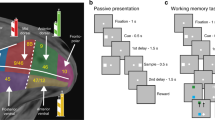Abstract
We studied the role of the dorsolateral prefrontal cortex in procedural learning. Normal subjects completed several blocks of a serial reaction time task using only one hand without or with concurrent non-invasive repetitive transcranial magnetic stimulation. To disrupt their function transiently, stimulation was applied at low intensity over the supplementary motor area or over the dorsolateral prefrontal cortex contralateral or ipsilateral to the hand used for the test. Stimulation to the contralateral dorsolateral prefrontal cortex markedly impaired procedural implicit learning, as documented by the lack of significant change in response times during the task. Stimulation over the other areas did not interfere with learning. These results support the notion of a critical role of contralateral dorsolateral prefrontal structures in learning of motor sequences.
Similar content being viewed by others
References
Baddeley A (1992) Working memory. Science 255: 556–559
Brasil-Neto JP, Pascual-Leone A, Valls-Solé J, Cohen LG, Hallett M (1992) Focal transcranial magnetic stimulation and response bias in a forced-choice task. J Neurol Neurosurg Psychiatry 55: 964–966
Fuster JM (1985) The prefrontal cortex, mediator of cross-temporal contingencies. Hum Neurobiol 4: 169–179
Fuster JM (1989) The prefrontal cortex: anatomy, physiology, and neuropsychology of the frontal lobe, 2nd edn. Raven Press, New York
Fuster JM, Alexander GE (1970) Neuron activity related to shortterm memory. Science 173: 652–654
Goldman-Rakic PS (1987) Circuitry of primate prefrontal cortex and regulation of behavior by representational memory. In: Plum F (ed) Handbook of physiology. Nervous system, vol V, Higher functions of the brain, part 1. American Physiological Society, Bethesda, Md
Gordon B (1988) Preserved learning of novel information in amnesia: evidence multiple memory systems. Brain Cogn 7: 257–282
Grafman J, Weingartner H, Newhouse PA, Thompson K, Lalonde F, Litvan I, Molchan S, Sunderland T (1990) Implicit learning in patients with Alzheimer's disease. Pharmacopsychiatry 23: 94–101
Harrington DL, Haaland KY, Yeo R A, Marder E (1990) Procedural memory in Parkinson's disease: impaired motor but visuoperceptual learning. J Clin Exp Neuropsychol 12: 323–339
Ivry RL, Keele SW (1989) Timing function of the cerebellum. J Cogn Neurosci 1: 136–152
Knopman DS (1991) Long-term retention of implicitly acquired learning in patients with Alzheimer's disease. J Clin Exp Neuropsychol 13: 880–894
Knopman DS, Nissen MJ (1987) Implicit learning in patients with probable Alzheimer's disease. Neurology 37: 784–788
Knopman DS, Nissen MJ (1991) Procedural learning is impaired in Huntington's disease: from the serial reaction time task. Neuropsychologia 29: 245–254
Leiner HC, Leiner AL, Dow RS (1991) The human cerebro-cerebellar system: its computing, cognitive, and language skills. Behav Brain Res 44: 113–128
Nissen MJ, Bullemer P (1987) Attentional requirements of learning: evidence from performance measures. Cogn Psychol 19: 1–32
Nissen MJ, Knopman DS, Schacter DL (1987) Neurochemical dissociation of memory systems. Neurology 37: 789–794
Nissen MJ, Willingham D, Hartman M (1989) Explicit and implicit remembering. When is learning preserved in amnesia? Neuropsychologia 27: 341–352
Pascual-Leone A, Grafman J, Clark K, Stewart M, Massaquoi S, Lou J-S, Hallett M (1993a) Procedural learning in Parkinson's disease and cerebellar degeneration. Ann Neurol 34: 594–602
Pascual-Leone A, Houser CM, Reese K, Shotland LI, Grafman J, Sato S, Valls-Solé J, Brasil-Neto JP, Wassermann EM, Cohen LG, Hallett M (1993b) Safety of rapid-rate transcranial magnetic stimulation in normal volunteers. Electroencephalogr Clin Neurophysiol 89: 120–130
Pascual-Leone A, Grafman J, Hallett M (1994a) Modulation of cortical motor output maps during development of implicit and explicit knowledge. Science 263: 1287–1289
Pascual-Leone A, Valls-Solé J, Brasil-Neto J, Grafman J, Hallett M (1994b) Akinesia in Parkinson's disease. II: Shortening of choice reaction time and movement time with subthreshold repetitive transcranial motor cortex stimulation. Neurology 44: 892–898
Pascual-Leone A, Cohen LG, Dang N, Brasil-Neto JP, Cammarota A, Hallett M (1995a) Modulation of human cortical motor outputs during the acquisition of new fine motor skills. J Neurophysiol (in press)
Pascual-Leone A, Grafman J, Cohen LG, Roth BJ, Hallett M (1995b) Transcranial magnetic stimulation: a new tool for the study of higher cognitive functions in humans. In: Grafman J, Boller F (eds) Handbook of neuropsychology, vol 9. Elsevier, Amsterdam (in press)
Passingham R (1993) The frontal lobes and voluntary action. Oxford University Press, Oxford
Phillips AG, Carr GD (1987) Cognition and the basal ganglia: a possible substrate for procedural knowledge. Can J Neurol Sci 14: 381–385
Roth BJ, Saypol JM, Hallett M, Cohen LG (1991) A theoretical calculation of the electric field induced in the cortex during transcranial magnetic stimulation. Electroencephalogr Clin Neurophysiol 81: 47–56
Saint CJ, Taylor AE, Lang AE (1988) Procedural learning and neostriatal dysfunction in man. Brain 111: 941–959
Schmahmann JD (1991) An emerging concept: the cerebellar contribution to higher function. Arch Neurol 48: 1178–1187
Squire LR (1992) Declarative and nondeclarative memory: multiple brain systems supporting learning and memory. J Cogn Neurosci 4: 232–243
Tofts PS (1990) The distribution of induced currents in magnetic stimulation of the nervous system. Proc R Soc Lond B Biol Sci 35: 1119–1128
Wassermann EW, Wang B, Toro C, Zeffiro T, Valls-Solé J, Pascual-Leone A Hallett M (1992) Projecting transcranial magetic Stimulation (TMS) maps into brain MRI. Soc Neurosci Abstr 18: 939
Willingham DB, Nissen MJ, Bullemer P (1989) On the development of procedural knowledge. J Exp Psychol Learn Mem Cogn 15: 1047–1060
Author information
Authors and Affiliations
Rights and permissions
About this article
Cite this article
Pascual-Leone, A., Wassermann, E.M., Grafman, J. et al. The role of the dorsolateral prefrontal cortex in implicit procedural learning. Exp Brain Res 107, 479–485 (1996). https://doi.org/10.1007/BF00230427
Received:
Accepted:
Issue Date:
DOI: https://doi.org/10.1007/BF00230427




